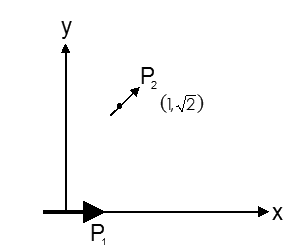Consider two electric dipoles P1 and P2 placed at (0, 0) and (1,√2 ) respectively. The centers of these dipoles are fixed so that they can rotate about their centers but the centers cannot move. Answer the following questions based on this arrangement.

Now P2 is fixed in the equilibrium position obtained in last question and P1 is released so that it can rotate freely. In its equilibrium position P1 will point along:
x-axis
along line joining P1 and P2
y- axis
a line making an acute angle with positive x-axis
The correct Answer is:D

Here In equilibrium P1 will align itself along the electric field of P2 . Check the direction of field at origin.
Topper's Solved these Questions
- BOOK - VMC MODULES ENGLISHCHAPTER - ELECTROSTATICSEXERCISE - JEE MAIN65videos
ELECTROSTATICS
- BOOK - VMC MODULES ENGLISHCHAPTER - ELECTROSTATICSEXERCISE - JEE Advanced (Archive)89videos
ELECTROSTATICS
- BOOK - VMC MODULES ENGLISHCHAPTER - ELECTROSTATICSEXERCISE - LEVEL - 1105videos
ELECTROSTATICS
- BOOK - VMC MODULES ENGLISHCHAPTER - ELECTROMAGNETIC INDUCTION & ALTERNATIVE CURRENT EXERCISE - IMPECCABLE52videos
ELECTROMAGNETIC INDUCTION & ALTERNATIVE CURRENT
- BOOK - VMC MODULES ENGLISHCHAPTER - ENERGY & MOMENTUMEXERCISE - JEE ADVANCE (ARCHIVE) - TRUE/FALSE TYPE1videos
ENERGY & MOMENTUM
Similar Questions
Consider two electric dipoles P1 and P2 placed at (0, 0) and (1,√2 ) respectively. The centers of these dipoles are fixed so that they can rotate about their centers but the centers cannot move. Answer the following questions based on this arrangement.

Initially P1 is held such that it is pointing towards positive x-axis and P2 is free to rotate. In the equilibrium position, P2 will point :View SolutionTwo short dipoles pˆk and P2ˆk are located at (0,0,0) & (1m,0,2m) respectivley. The resultant electric field due to the two dipoles at the point (1m,0,0) is
View Solution
Knowledge Check
- Question 1 - Select One
Electric field intensity (E) due to an electric dipole varies with distance (r ) from the point of the center of dipole as :
A1rand1r2B1r2and1rC1r3and1r3D1r3and1r2
Two short dipoles pˆk and P2ˆk are located at (0,0,0) & (1m,0,2m) respectivley. The resultant electric field due to the two dipoles at the point (1m,0,0) is
View SolutionAn electric dipole of dipole moment p is placed in a uniform external electric field E. Then, the
View SolutionTwo identical electric dipoles of dipole moments p are placed as shown in the figure. The electrostatic force on dipole placed along x-axis is (d << r) (14πε0 )
 View Solution
View SolutionIf A(1,1)andB(−2,3) are two fixed points, find the locus of a point P so that area of ΔPAB is 9 units.
View SolutionThe coordinates of the point AandB are (a,0) and (−a,0), respectively. If a point P moves so that PA2−PB2=2k2, when k is constant, then find the equation to the locus of the point P.
View Solution
Two point electric dipoles with dipole moment P1 and P2 are separated by a distance r with their dipole axes mutually perpendicular as shown. The force of interaction between the dipoles is (where k=14πε0)View SolutionA tiny electric dipole of dipole moment →P=P0ˆj is placed at point (l,0). There exists an electric field →E=2ax2ˆi+(2by2+2cy)ˆj.
View Solution
